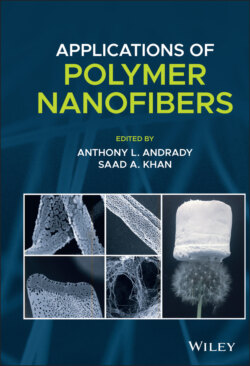Читать книгу Applications of Polymer Nanofibers - Группа авторов - Страница 20
1.4.3 Additivities to Tune Solution Properties 1.4.3.1 Surface Tension
ОглавлениеThe polymer/solvent system also dictates other important solution parameters that influence the electrospinning process, specifically, surface tension and conductivity. Electrospinning requires the electrostatic force to overcome surface tension of the solution (Andrady 2008; Ramakrishna 2005). Surface tension acts to minimize the surface area per unit mass of fluid, i.e. spherical shapes which result in beaded fibers and affects the bending during the whipping instability (Ramakrishna 2005). Generally, lower surface tension is preferred for electrospinning (Andrady 2008).
The surface tension is affected by the solvent and polymer concentration (Andrady 2008; Ramakrishna 2005). Typically, the surface tension decreases with increasing polymer concentration. To further reduce the surface tension, cosolvents such as ethanol or surfactants can be added to the polymer solution. Small amounts of surfactants (concentrations ~0.01 to 1 mM) dramatically decrease surface tension and facilitate electrospinning (Andrady 2008; Ramakrishna 2005). For example, 5–15 w/v% polystyrene in DMF/tetrahydrofuran only formed bead‐free nanofibers with the addition of surfactant (dodecyl trimethyl ammonium bromide). Triton X‐100 is a common nonionic surfactant used in aqueous systems such as polyvinyl alcohol and PEO and their blends. While nonionic surfactants change in conductivity relative to the change in surface tension is minimal, ionic surfactants such as sodium dodecyl sulfate affects surface tension as well as conductivity. The relative contribution of the conductivity and surface tension cannot be determined. Practically, ionic surfactants are effective in improving fiber quality. Zwitterionic surfactants may be especially effective at increasing the surface charge density. Nanofiber size can be affected by surfactant concentration, i.e. size decreases monotonically with surfactant concentration (Lin et al. 2004). Although, most often, cosolvents/surfactants to reduce surface tension are used to reduce beading and create uniform fibers.
